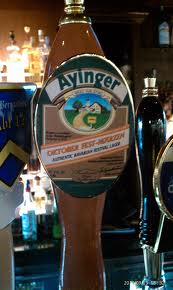 Long-time readers will know that I am fascinated by the flavour and aroma effects of beer packaging. Does beer taste differently in a keg vs. a bottle vs. a can? I have explored this issue a couple of times here (I did a Beer 101 on it and also did a comparison taste test of Yukon Lead Dog Ale). Another opportunity came up last week, and I couldn’t let it pass.
Long-time readers will know that I am fascinated by the flavour and aroma effects of beer packaging. Does beer taste differently in a keg vs. a bottle vs. a can? I have explored this issue a couple of times here (I did a Beer 101 on it and also did a comparison taste test of Yukon Lead Dog Ale). Another opportunity came up last week, and I couldn’t let it pass.
I did my occasional beer tasting evening at the Sugar Bowl last Wednesday. We chose a German beer styles theme, in honour of Oktoberfest, which included Ayinger Oktoberfest/Marzen. For the tasting we brought in bottles, which are easier to handle when doing small samples. However the same beer was also available on tap. Once I had completed my  beer educator duties, I got a sample of each to test side-by-side.
beer educator duties, I got a sample of each to test side-by-side.
I didn’t have my notebook with me (as I wasn’t planning this comparison and generally don’t think ahead all that well), so couldn’t take detailed notes. But the difference was stark enough that my general impressions will suffice. First, I should highlight that I could tell it was the same beer, but the differences were clearly observable. The bottled version, surprisingly, had a stronger aroma – the bready, sweet character came through fairly distinctly – while the tap version was more subdued. In the flavour the tap offered a more rounded, fuller body and the breadiness came out more. The bottle was fruitier with a sharper finish. Carbonation levels seemed fairly similar. In terms of personal preference I enjoyed the tap version more, with the exception of the aroma. However, that is a secondary concern. What is more relevant is the effects on each beer. The tap broadens the beer but, for some reason, weakens the aroma.
These results roughly parallel my experience with the Lead Dog experiment, where the kegged version was softer, more rounded and less sharp. For the moment I will leave to others to postulate the reasons for the difference. I will allow myself to contemplate the experience.
And, for the record, the method did have limitations. It was not a blind test – I knew which was which. The beer were in different shaped glasses, and both had been sitting out for a short while until I could get to them (the bottled version sat longer, but was in an aroma-favourable glass – which in my opinion may have equalized the aroma situation). They were at the same temperature, around cellar temperature. I cannot confirm whether they were from the same batch, although Ayinger is a pretty big brewery so I imagine has QC down pretty well. None of this matters much, since my goal was not scientific rigour but experiential learning. But I offer it to the science-minded among you.

September 27, 2011 at 9:55 AM
So how much of the difference between bottles and kegs is specific to a bar/tap/line? The manner in which a line is cleaned, for example, can surely influence the taste/aroma. Do you get the impression that there are general differences, independant of the particulars of the way the beer is tapped?
September 27, 2011 at 5:09 PM
Isotopic, I agree that tap line condition, etc. can make a difference – but usually in a bad way (because it is not clean). If it is properly maintained, the difference still holds. I contend there is a consistent difference between tap and bottle regardless of the tap set-up. I have had too many Alley Kat Full Moon’s to believe otherwise. The beer is fuller and rounder on tap than when I sample it from the bottle (to be clear, I enjoy it either way). So, I do believe the effect is more general. Maybe those with more scientific backgrounds than I can offer some scienc-y reason why this is so.
September 27, 2011 at 5:29 PM
That’s my experience as well, that poorly maintained tap lines yield soapy tasting beer (and poorly rinsed pint-glasses!). I wasn’t sure if there was a more subtle effect, but it’s good to hear from an expert that it doesn’t appear to be perceptible.
September 27, 2011 at 6:27 PM
Another possible variable. Usually large breweries, that pasteurize, only pasteurize bottles/cans and not kegs. With bottle conditioned beer that may not be the case. Although, the beer is probably filtered to remove the house yeast. So it is possible that it is flash pasteurized on the way to the filler and the yeast and primer added inline after the flasher. This is just a guess as I do not know how they ensure proper cell counts in the bottle.
September 27, 2011 at 9:44 PM
Could there also be a difference between a newly tapped keg and an almost tapped out keg? I know there is definitely a difference from the first pint to the last pint pulled from a keg on my homebrew setup, especially in terms of aroma.